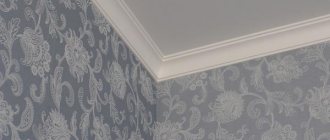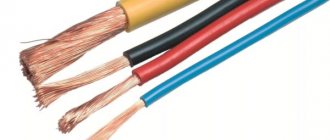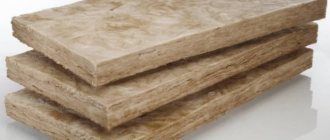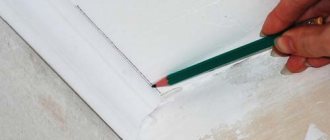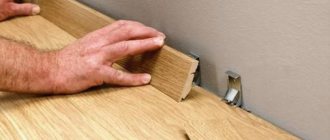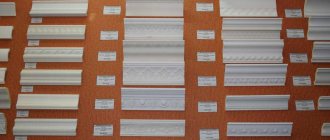What material to choose for a ceiling plinth for your home?
Ceiling plinths help complete the ceiling design, emphasize the style, decorate the room and help hide minor flaws. This decorative element has many other names: fillet, molding, frieze, baguette, as well as interior cornice.
Moreover, there are many different models on sale.
The article describes how to choose the right decor, taking into account the properties of the room, what material the ceiling skirting boards are made of, the advantages and disadvantages of the materials used, and even the best budget options.
Foam skirting boards
Foam baguettes are the best choice if you want to keep costs to a minimum. So, as for which ceiling plinth is better to choose in order to save money, it’s definitely foam plastic. This is a very cheap material, and the products are easy to install (they can be cut with a regular knife). Read also: “Plinths for suspended ceilings: how to choose.” But polystyrene foam also has disadvantages.
This is, first of all:
- low strength (if the plinth is installed at a level where residents can touch it, it will quickly become unusable; at the same time, this drawback cannot be attributed to ceiling moldings, since they are located high);
- fire hazard (foam is susceptible to fire, just like wood, which is also often used to make baseboards).
Polyurethane
Polyurethanes are also popular in the production of decor, including fillets with a pattern or smooth texture. Due to this, with their help you can create interiors both in the Scandinavian style and in the universal classics with monograms and flowers. They are somewhat more expensive, but still cheaper than gypsum panels or wood. They have several undeniable advantages over cheaper raw materials:
- Durability. The material is not subject to degradation, and therefore can last 30 years or more. If treated with care, the surface will not dry out, crack, and with regular cleaning it will not darken.
- Resistant to temperature changes. This is a plus for unheated rooms. The material will not dry out after the next frost and will easily withstand the summer heat.
- Low water absorption. Due to this, skirting boards are often installed in bathrooms, indoor pools or kitchens. Condensation does not collect under the surface, and fungus does not develop. This additionally protects the walls from destruction.
- Easy to install. The product is quite flexible, and therefore easily fits on uneven walls. At the same time, it can be easily cut with a regular knife at the desired angle.
The only downside is the higher price, however, it is more than compensated by its noble appearance. The structure is difficult to distinguish from plaster at first glance.
Polystyrene foam skirting boards
Extruded polystyrene foam is a more durable analogue of polystyrene foam, which is also used for the production of ceiling baguettes. The question often arises about what the name of a ceiling plinth made of this material is, since there are both polyurethane ceiling plinths and polyurethane foam products. But no matter what they are called, they are made from polystyrene foam.
This material has two advantages that foam does not have:
- greater strength (despite the fact that polystyrene foam can be cut with an ordinary sharp knife, it does not deform under strong pressure, so these products are also used to create floor skirting boards, and not just ceiling ones);
- does not burn (with short contact with fire, no fire occurs, but despite this, during a fire the baseboards completely burn out).
The cost of polystyrene foam products is higher than foam ceiling skirting boards, but they are still considered cheap.
The best recommendations for installing ceiling moldings
To install the materials in question, you need to follow a few simple tips:
- If the plinth is made of lightweight material (see above), then putty or glue is suitable for attaching it.
- In cases where the wall base does not have proper evenness, you need to use an elastic plinth. In principle, when the baseboard does not adhere sufficiently to the base, it can be reinforced with acrylic sealant (if the base of the baguette allows it).
- In the case when the installation of the plinth is carried out UNDER suspended ceilings, it is necessary to remove the adhesive in time (before hardening).
- Depending on the production material, it is necessary to calculate the installation of the length of the dies at right angles.
- Ceiling baguettes can be painted. If the layer is applied with a brush, then you need to roll it out using a roller method until it touches the wall.
- Any adhesive that gets onto the front side must be removed immediately using a soft sponge (or rag).
- In cases where trimming fillets is required, you should always use a miter box.
Wooden skirting boards
When thinking about which ceiling plinth to choose, you should not ignore wooden products. Wood is a natural and noble material; it gives the room an atmosphere of luxury. This is especially true for wood species such as oak, ash, and mahogany.
Baguettes made from this material are the most expensive. But the price range is wide: for example, the price difference between a simple pine product and a carved mahogany plinth can reach 1000%.
When deciding which ceiling plinth is best to choose, you need to take into account that wooden products are much more difficult to process. You will have to adjust the corners of the planks with a hacksaw with fine teeth, and file the joints. In addition, skirting boards made from other materials can be easily puttied in case of a mistake, but special care must be taken with wood. Even if you choose the exact shade of the putty composition, on wood with a complex texture the slightest mistakes will be obvious. Therefore, if you have no experience working with such skirting boards, but need to do the work yourself, it is better to choose cheaper types of wood with a simple pattern.
It is also worth remembering that wood can rot, mold, become deformed due to fluctuations in humidity and temperature, and become a habitat for bugs. To prevent this from happening, products made from this material must be treated with antiseptics and covered with several layers of varnish.
Gypsum
Traditionally, complex patterned stucco molding is made from it. It looks luxurious and creates a voluminous texture of the baseboard. Its main advantage is that gypsum absorbs excess moisture from the air well, but does not accumulate it, but releases it back over time, maintaining a consistently comfortable microclimate.
At the same time, condensation does not collect under it, and mold does not develop. However, such fillets are difficult to install due to their fragility and heavy weight.
Skirting width
When thinking about how to choose the right ceiling plinth, you should pay attention to its width. There are products on sale that have this parameter in the range from 1 to 20 centimeters. The choice is not so easy to make, since the decision depends not only on personal taste.
Wide baseboards visually smooth out corners, and as a result the room looks more rounded and cozy. This happens due to the characteristics of the human psyche: sharp corners seem aggressive, while rounded ones evoke a feeling of peace.
The width of the baguettes determines how well it will be possible to hide defects in the joints of the ceiling and walls. Differences in ceiling height in the corners also attract attention, and skirting boards make them invisible. Wide planks also help hide the joints of the suspended structure with the walls.
But such skirting boards are not suitable for all rooms. Thus, in rooms with a small area and low height, they do not look the best; in addition, they visually reduce the space even more. For small rooms, narrow skirting boards of simple shapes are more suitable.
Installation of ceiling plinth, detailed video instructions:
Premium class
3rd place: “Ceiling plinth (cornice) Decomaster 167S-118 (size 35x35x2400)”
This ceiling molding is particularly moisture resistant and the manufacturer claims it as a universal model. The presence of gold-embroidered patterns significantly increases the cost of the sample, regardless of its standard base. The main surface of this element does not have any sufficient structure underneath it, which may be subject to destruction. Accordingly, this option should only be a good basis for designers, rather than being applicable for a specific home decoration. The recommended price for retail chains is 490 rubles.
Ceiling plinth (cornice) Decomaster 167S-118 (size 35x35x2400)
Advantages:
- Excellent resistance to water;
- An excellent base for a design base;
- Normal price.
Flaws:
- Not detected.
2nd place: “CEILING SKIRTIN BOARD WITH DECOMASTER PATTERN 155-115DM (50*50*2400 MM)”
Their intended purpose, specifically for these models, remains only the choice of the owner of the space, who is engaged in finishing. In principle, the finish can also be bronze, which does not deprive the entire body of producing it in silver. Thus, it becomes possible to mark the plate in accordance with the standard design on the corresponding sites (from “all tools” to “Yandex.market”). They cost 673 rubles.
CEILING BOARD WITH DECOMASTER PATTERN 155-115DM (50*50*2400 MM)
Advantages:
- Easy installation;
- Availability of a drawing;
- High quality production.
Flaws:
- Not detected.
1st place: “Ceiling plinth Decomaster D214B (150*38*2000mm)”
This ceiling plinth is really the best example among the real ones. Not only do his formations appear and run in intricate patterns, but he is also able to competently disguise the necessary angles during finishing work. Thus, these dies will easily restore any finish, even if they were not the original material. The recommended price for retail chains is 1120 rubles.
ceiling lining Decomaster D214B (150*38*2000mm)
Advantages:
- Normal price/quality ratio;
- Excellent corner finishing;
- The best characteristic from the consumer.
Flaws:
- Not detected.
Skirting color
There are options for ceiling plinths in various colors on sale, although most initially shine white. Plastic products are sold already painted in any color, and baguettes made from other materials can be painted in the shade that is needed.
White baseboards visually increase the height of the room; this effect is even better if the ceiling is painted the same color. Therefore, for rooms with low ceilings, white baguettes are the best option.
Wide baseboards that match the tone of the walls, on the contrary, make the room smaller. They can be used in spacious rooms. In small rooms they will look too rough and out of place.
To prevent a room from being variegated, it should contain no more than three primary colors. But white and black colors can be combined with any others. If white color visually expands the space, then black, on the contrary, makes the room smaller and makes it more subdued. That is why white products are the most popular.
Skirting boards in contrasting tones (for example, a combination of stained oak with light ceilings and walls) look quite impressive in rooms of considerable height. But at the same time, the color of the baguettes must match some of the interior items.
The article described what types of ceiling plinths there are. But it is impossible to say which of them is better to buy - it depends on the specific situation and the personal taste of the homeowners.
We focus on design
The role of fillets in interior design should not be underestimated. With the help of discreet, but noticeable elements, it is easiest to emphasize the chosen style direction. Ceiling plinth can become the finishing touch and create complete harmony.
Classic style
Interiors made in a classic style can easily be spoiled by just one detail, for example, by using a banal rubber or plastic plinth for a stretch ceiling in the decoration. For an elegant environment, elegant baguettes made of polyvinyl chloride imitating wood or exquisite stucco, or plinths made of natural wood are more suitable.
The color of the fillets should be in harmony with the rest of the finish
When choosing a color, you should focus on the general background in the interior: sharp contrasts with the decoration of the walls or ceiling are unacceptable. If it’s difficult for you to decide, give preference to white fillets. They will fit harmoniously into any interior, regardless of the shades in which it is made. Golden-colored borders with bronze or gilding will also look good - a little pretentiousness to the classics won’t hurt. When choosing a plinth for a stretch ceiling, you can first study photos of suitable solutions in catalogs.
Carved bronze borders are ideal for rooms with a classic interior
Country
The interior in a rural style focuses on the naturalness of materials and suggests the use of wooden decorative elements as accents. And then the optimal choice would be plinths for a stretch ceiling made of natural wood, but a high-quality imitation of this material will also do. The interior design will be complemented by carefully selected fastener elements - they can be made in the same style, representing metal strips with a touch of patina, or imitate carpet any details.
Wood fillets will organically replace analogues that imitate natural material
Modern
The expression of this stylistic direction implies a predominance of curves and roundness. In the interior, it will look good to have wide and flexible skirting boards that can carefully wrap around any curve. An excellent option is the choice of flexible polyurethane fillets with a relief pattern in the form of floral designs. Modern loves the play of light, so a plinth with additional lighting around the perimeter of the ceiling will provide soft contour lighting.
The presence of many roundings places special demands on the flexibility of fillets
Modern style
Functionality and conciseness - this is how you can characterize the requirements for choosing skirting boards for rooms whose interior is made in a modern style. Pretentiousness and luxury are not inherent in it, and then the best option would be simple skirting boards with a smooth surface without relief patterns. Both polyurethane products and cheaper analogues - for example, made of polystyrene foam - are suitable.
The cost does not matter - the main thing is that the plinth does not stand out from the general style
Types of texture
Ceiling plinth (curb, fillet, cornice) is classified according to the following texture parameters.
- Smooth. The outer surface does not have patterned ornaments or other relief. This is a discreet and stylish option that fits universally into almost any interior style.
- Extruded. It has a longitudinal relief made by rolling.
- Injection. The relief pattern is applied convexly and has a grainy structure. Outwardly it resembles stucco. This plinth is a striking element of the interior and, in fact, is an independent decor.
When choosing the texture of the ceiling plinth, it is important to understand that this criterion is not decisive! The same shape of the transverse profile, not to mention large patterns, will look completely different on cornices of different widths!
Areas of product use
It must be taken into account that ceiling plinths differ not only in the material from which they are made, but also in their area of application. There are certain recommendations that allow you to ensure that the selected option fits well into the overall appearance of the room.
- PVC fillets. This option harmonizes best with the finishing of plastic panels. In addition, many varieties have a special groove for faster installation. In addition, PVC plinth for stretch ceilings is an excellent solution.
- Styrofoam. Most often used for finishing structures made from gypsum plaster boards. Excellent for walls and ceilings finished with putty or plaster. In this case, not glue, but a putty solution is used for fixation.
- Expanded polystyrene. A good solution for surfaces made of plastic and gypsum materials. In this case, a more suitable method of fastening is selected - glue or putty.
- Polyurethane. Universal products that are suitable for many materials. It happens that this is the only possible option when there are many curved areas.
- Gypsum skirting boards. Of course, this type is more suitable for classical compositions. Very often the finishing is done partially, for example, parts are installed exclusively in the corners. Fixation occurs on putty.
- Wooden crafts. This option is used quite rarely. It is better to combine it with wood materials to achieve greater harmony.
Photo gallery: various types of ceiling plinths in the interior (16 photos)





